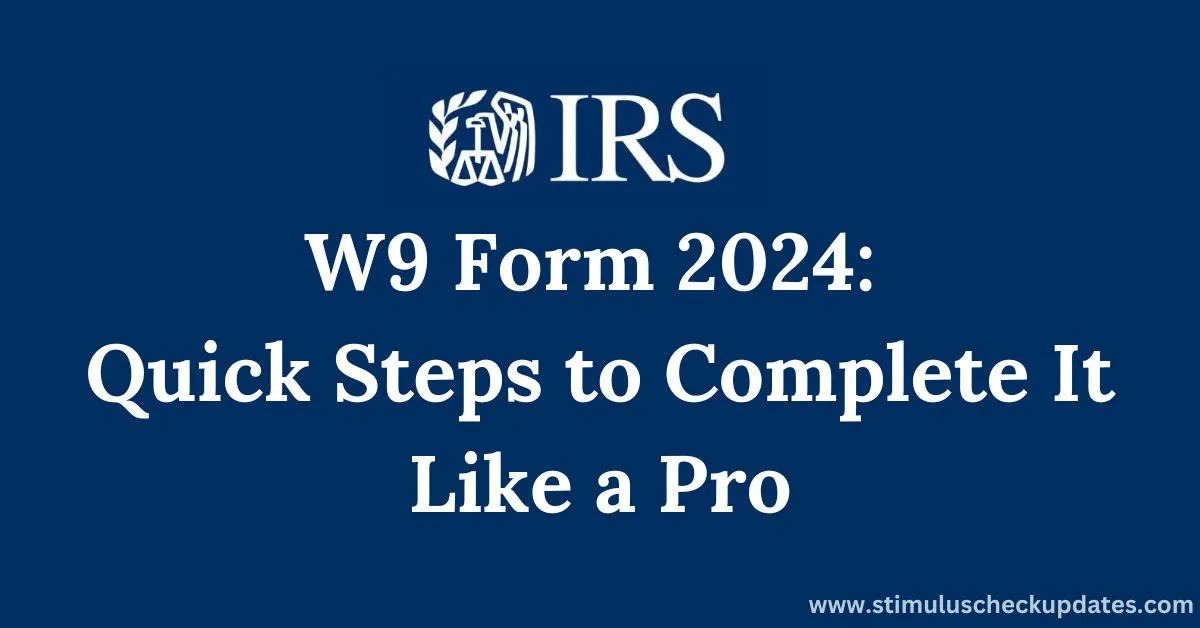W9 Form 2024
The W9 Form 2024 is a crucial document in the United States tax system, serving as a request for taxpayer identification number and certification. Whether you’re a freelancer, independent contractor, or business owner, understanding the ins and outs of the W9 Form is essential for accurate tax reporting and compliance. This comprehensive guide will walk you through everything you need to know about the W9 Form for 2024, including its purpose, how to fill it out correctly, and common questions that arise.
What is a W9 Form?
The W9 Form, officially titled “Request for Taxpayer Identification Number and Certification,” is an Internal Revenue Service (IRS) document used to gather information about individuals and entities for tax reporting purposes. The form is typically requested by businesses or financial institutions when they need to report payments made to you.
Key Points About the W9 Form:
- It’s used to provide your Taxpayer Identification Number (TIN)
- It certifies that the TIN you’re providing is correct
- It confirms whether you’re subject to backup withholding
- The form is not submitted to the IRS but kept on file by the requester
Why is the W9 Form Important in 2024?
As we move into 2024, the importance of the W9 Form remains unchanged. Here’s why it continues to be a critical document:
- Tax Reporting Accuracy: Ensures that businesses have the correct information to report payments to the IRS.
- Prevent Backup Withholding: Properly completed W9 forms help avoid unnecessary backup withholding on payments.
- Facilitate 1099 Reporting: Essential for accurate completion of 1099 forms for independent contractors.
- Legal Compliance: Helps both parties comply with IRS regulations and avoid potential penalties.
Changes to the W9 Form in 2024
While the IRS regularly reviews and updates its forms, as of the latest information available, there have been no major changes to the W9 Form for 2024. However, it’s always important to use the most current version of the form, which can be found on the official IRS website.
Key Elements of the 2024 W9 Form:
- Name: As shown on your income tax return
- Business Name/Disregarded Entity Name: If different from above
- Federal Tax Classification: Your business structure (e.g., individual, corporation, partnership)
- Exemptions: Codes for exempt payees and from FATCA reporting
- Address: Your street address, city, state, and ZIP code
- Taxpayer Identification Number (TIN): Your Social Security Number (SSN) or Employer Identification Number (EIN)
- Certification: Your signature and date
How to Fill Out a W9 Form in 2024
Completing the W9 Form 2024 correctly is crucial to avoid any issues with tax reporting. Here’s a step-by-step guide:
Step 1: Provide Your Name and Business Information
- Enter your name as shown on your tax return
- If you have a business name or disregarded entity name, enter it on line 2
Step 2: Select Your Federal Tax Classification
Choose the appropriate box for your federal tax classification:
- Individual/Sole proprietor
- C Corporation
- S Corporation
- Partnership
- Trust/Estate
- Limited Liability Company (LLC)
- Other
Step 3: Enter Exemption Codes (if applicable)
- Exempt payee code (if any)
- Exemption from FATCA reporting code (if any)
Step 4: Provide Your Address
Enter your street address, city, state, and ZIP code.
Step 5: Enter Your Taxpayer Identification Number (TIN)
- For individuals, this is typically your Social Security Number (SSN)
- For entities, use your Employer Identification Number (EIN)
Step 6: Sign and Date the Form
By signing, you’re certifying under penalty of perjury that:
- The number shown is your correct TIN
- You’re not subject to backup withholding
- You’re a U.S. citizen or other U.S. person
- The FATCA code(s) entered (if any) are correct

Common Mistakes to Avoid on the W9 Form 2024
When filling out your W9 Form, be careful to avoid these common errors:
- Providing an incorrect TIN: Double-check your SSN or EIN for accuracy.
- Using an outdated form: Always use the most current version from the IRS website.
- Forgetting to sign and date: An unsigned form is considered invalid.
- Inconsistent name usage: Ensure the name matches your tax records.
- Incorrect business classification: Select the appropriate box for your entity type.
W9 Form vs. Other Tax Forms
Understanding how the W9 Form relates to other tax documents can help clarify its purpose:
W9 vs. W-4
- W9 Form: Used for independent contractors, freelancers, and vendors
- W-4 Form: Used for employees to determine federal income tax withholding
W9 vs. 1099
- W9 Form: Collected by businesses to obtain information
- 1099 Forms: Issued by businesses to report payments made to contractors
W9 vs. W-8BEN
- W9 Form: For U.S. persons (citizens and resident aliens)
- W-8BEN Form: For foreign persons to claim treaty benefits
When Do You Need to Submit a W9 Form?
You may be asked to complete a W9 Form 2024 in various situations:
- Starting work as an independent contractor
- Opening a new bank account
- Making investments in stocks or mutual funds
- Engaging in real estate transactions
- Cancelling debt with a financial institution
Protecting Your Information on the W9 Form
Given the sensitive nature of the information on a W9 Form, it’s crucial to protect your data:
- Verify the requester: Ensure you’re providing the form to a legitimate business or institution.
- Secure transmission: Use encrypted methods when sending the form electronically.
- Limited distribution: Only provide the form to entities that require it for tax purposes.
- Redact when possible: If a full SSN isn’t required, consider providing only the last four digits.
Digital Submission of W9 Forms in 2024
As digital processes become more prevalent, many businesses are moving towards electronic W9 submission:
- E-signature platforms: Services like DocuSign or Adobe Sign for secure digital signing
- Secure portals: Many companies offer secure online portals for form submission
- IRS guidelines: Electronic W9 forms must meet IRS requirements for electronic signatures
W9 Form and Tax Implications for Freelancers and Contractors
For those in the gig economy or working as independent contractors, understanding the W9 Form 2024 is crucial:
- Income reporting: Payments reported on 1099 forms based on W9 information
- Self-employment tax: May be required to pay self-employment tax on income
- Estimated tax payments: Consider making quarterly estimated tax payments
- Record keeping: Maintain accurate records of all income and expenses
FAQs About the W9 Form 2024
Q1: Do I need to submit a new W9 Form every year?
A1: Generally, no. You only need to submit a new W9 Form if your information changes or if requested by the payer.
Q2: Can I refuse to provide a W9 Form?
A2: You can refuse, but the payer may be required to withhold 24% of your payments as backup withholding.
Q3: Is the W9 Form only for businesses?
A3: No, individuals can also be required to fill out a W9 Form, especially freelancers and independent contractors.
Q4: How long should a business keep W9 Forms on file?
A4: The IRS recommends keeping W9 Forms for at least four years after the date the last payment is reported.
Q5: Can I email my completed W9 Form?
A5: While possible, it’s not recommended due to security concerns. Use secure electronic methods or hand-deliver the form when possible.
Conclusion
Understanding the W9 Form 2024 is essential for proper tax reporting and compliance. Whether you’re a business owner, freelancer, or independent contractor, knowing how to correctly complete and submit this form will help ensure smooth financial operations and avoid potential issues with the IRS. Remember to always use the most current version of the form and consult with a tax professional if you have specific questions about your situation.
For the most up-to-date information and to download the latest version of the W9 Form, visit the official IRS website.
